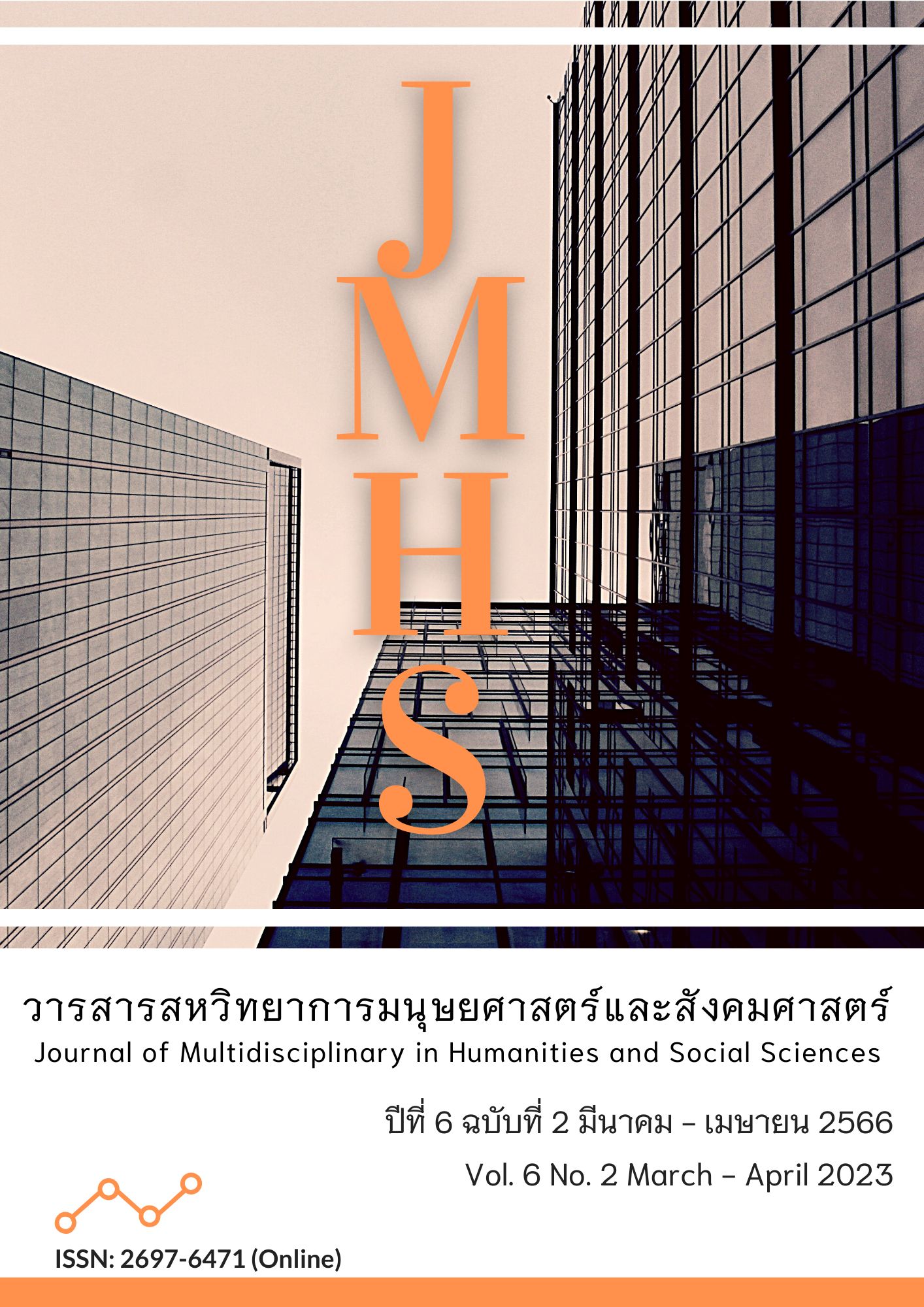The Effects of Mathematics Learning Activities Base on Ration Proportion and Percentage for Matthayom Sueksa One Students Instructed on the Basis of Constructivist Theory and the Stad Cooperative Learning Technique
Main Article Content
Abstract
This research aimed to (1) study the learning activities. Based on the concept of constructivism in conjunction with a collaborative learning method with effective STAD techniques; (2) compare student achievement; and (3) study the satisfaction of students with the activity-based learning theory of constructivist Whistler and how cooperative learning techniques apply STAD mathematics, the ratio, proportion, and percentages. The subjects for this study were 35 grade 1 students studying in the second semester of the academic year 2019, one classroom at Ramkhamhaeng University Demonstration School. The sample group was selected by cluster random sampling. The instrument used for data collection measures (1) learning activities, (2) test achievement with a reliability of .916, an index of difficulty between .38-.79, with discrimination between .23-.75, and (3) the satisfaction of the students towards learning with a liability of .67. The research was quasi-experimental, a one-shot case study. The data were analyzed by percentage, mean, standard deviation, t test for dependent samples, and t test for one sample.
The research results showed that: (1) the results of learning activities based on the constructivist theory concept together with the collaborative learning method using STAD technique in mathematics were ratio, proportion, and percentage. Of grade 1 students, they have an efficiency of 90.96/88.00 meeting the established 80/80 efficiency criteria; (2) achievement post-test than pre-test at the statistical level of significance .05; and (3) the level of satisfaction with the overall learning at a high-level an average of 4.17 and standard deviation of .94.
Article Details

This work is licensed under a Creative Commons Attribution-NonCommercial-NoDerivatives 4.0 International License.
Views and opinions appearing in the Journal it is the responsibility of the author of the article, and does not constitute the view and responsibility of the editorial team.
References
กระทรวงศึกษาธิการ. (2553). แนวทางการจัดการเรียนรู้ตามหลักสูตรแกนกลางการศึกษาขั้นพื้นฐาน พ.ศ. 2551. กรุงเทพฯ: กระทรวงศึกษาธิการ.
กระทรวงศึกษาธิการ. (2560). ตัวชี้วัดและสาระการเรียนรู้แกนกลาง กลุ่มสาระการเรียนรู้คณิตศาสตร์ (ฉบับปรับปรุง พ.ศ. 2560) ตามหลักสูตรแกนกลางการศึกษาขั้นพื้นฐาน พ.ศ. 2551. กรุงเทพฯ: กระทรวงศึกษาธิการ.
ขัณธ์ชัย อธิเกียรติ และ ธนารักษ์ สารเถื่อนแก้ว. (2561). การสอนแบบทันสมัยและเทคนิควิธีสอนแนวใหม่. สืบค้นจากhttps://regis.skru.ac.th/RegisWeb/webpage/addnews/data/2017-07-24_078.pdf
ชัยวัฒน์ สุทธิรัตน์. (2552). 80 นวัตกรรมการจัดการเรียนรู้ที่่เน้นผู้เรียนเป็นสำคัญ. กรุงเทพฯ: แดเน็ทซ์ อินเตอร์คอร์ปอเรชั่น.
ชูศรี วงศ์รัตนะ. (2550). เทคนิคการใช้สถิติเพื่อการวิจัย. (พิมพ์ครั้งที่ 10). นนทบุรี: ไทยเนรมิตกิจ.
ทิศนา แขมมณี. (2545). รูปแบบการเรียนการสอนทางเลือกที่หลากหลาย. กรุงเทพฯ: ด่านสุธาการพิมพ์.
นพพร แหยมแสง. (2556). พฤติกรรมการสอนคณิตศาสตร์ 1. (พิมพ์ครั้งที่ 2). กรุงเทพฯ: มหาวิทยาลัยรามคำแหง.
นพพร แหยมแสง และ อุไร ซิรัมย์. (2561). พฤติกรรมการสอนคณิตศาสตร์ 1 (พิมพ์ครั้งที่ 3). กรุงเทพฯ: มหาวิทยาลัยรามคำแหง.
พิชิต ฤทธิ์จรูญ. (2552). หลักการวัดและการประเมินผลการศึกษา. กรุงเทพฯ: เฮ้าส์ ออฟ เคอร์มิสท์.
พรพิมล พรพีรชนม์. (2550). การจัดกระบวนการเรียนรู้. สงขลา: เทมการพิมพ์สงขลา.
เพ็ญประภา อุดมฤทธิ์. (2558). การศึกษาผลสัมฤทธิ์ทางการเรียนคณิตศาสตร์ โดยใช้ชุดการเรียนการสอน เรื่อง สมการกําลังสอง ของนักเรียนชั้นมัธยมศึกษาปีที่ 3 ตามแนวคิดคอนสตรัคติวิสต์ร่วมกับวิธีการเรียนแบบร่วมมือเทคนิค STAD(วิทยานิพนธ์ศึกษาศาสตรมหาบัณฑิต). มหาวิทยาลัยรามคำแหง.
มหาวิทยาลัยราชภัฏวไลยอลงกรณ์ ในพระบรมราชูปถัมภ์. (2553). คู่มือการจัดระบบการเรียนการสอนที่ยึดผู้เรียนเป็นศูนย์กลางการเรียนรู้. (พิมพ์ครั้งที่ 1). พระนครศรีอยุธยา: เทียนวัฒนา พริ้นท์ติ้ง.
มลฤดี สิงห์นุกูล. (2555). การศึกษาผลสัมฤทธิ์และความพึงพอใจในการเรียน เรื่อง สมการเชิงเส้นตัวแปรเดียว ชั้นมัธยมศึกษาปีที่ 1 ตามแนวทฤษฎีการสร้างองค์ความรู้ด้วยตนเองร่วมกับวิธีเรียนแบบร่วมมือเทคนิค STAD(วิทยานิพนธ์ศึกษาศาสตรมหาบัณฑิต). มหาวิทยาลัยรามคำแหง.
ยุพิน พิพิธกุล. (2546). การเรียนการสอนคณิตศาสตร์ยุคปฏิรูปการศึกษา. กรุงเทพฯ: บพิธการพิมพ์.
วัลลดา เกตุจันทร. (2558). การศึกษาผลสัมฤทธิ์ทางการเรียนวิชาคณิตศาสตร์ เรื่อง อัตราส่วนตรีโกณมิติ ของนักเรียนชั้นมัธยมศึกษาปีที่ 5 ตามแนวคิดทฤษฎีคอนสตรัคติวิสต์ร่วมกับวิธีเรียนแบบร่วมมือด้วย เทคนิค STAD(วิทยานิพนธ์ศึกษาศาสตรมหาบัณฑิต). มหาวิทยาลัยรามคำแหง.
วิมลรัตน์ สุนทรโรจน์. (2545). เอกสารประกอบการสอนวิชา 0506703 พัฒนาการเรียนการสอน. มหาสารคาม: มหาวิทยาลัยมหาสารคาม.
เสนอ ภิรมจิตรผ่อง. (2542). การประเมินผลภาคปฏิบัติ. อุบลราชธานี: ภาควิชาทดสอบและวิจัยการศึกษา คณะครุศาสตร์, สถาบันราชภัฏอุบลราชธานี.
สถาบันทดสอบทางการศึกษาแห่งชาติ (องค์การมหาชน). (2562). รายงานผลการทดสอบทางการศึกษาระดับชาติขั้นพื้นฐาน (O-NET) ชั้นมัธยมศึกษาปีที่ 3 ปีการศึกษา 2561. สืบค้นจาก http://www.newonetresult.niets.or.th/AnnouncementWeb/PDF/SummaryONETM3_2561.pdf
สิริพร ทิพย์คง. (2545). หลักสูตรและการสอนคณิตศาสตร์. กรุงเทพฯ: สถาบันพัฒนาคุณภาพวิชาการ.
สุคนธ์ สินธพานนท์. (2545). การจัดกระบวนการเรียนรู้: เน้นผู้เรียนเป็นสำคัญ. (พิมพ์ครั้งที่ 2). กรุงเทพฯ: อักษรเจริญทัศน์.
สมบูรณ์ ตันยะ. (2545). การประเมินทางการศึกษา. กรุงเทพฯ: สุวีริยาสาส์น.
สำนักงานเลขาธิการสภาการศึกษา. (2563). การจัดการเรียนรู้ฐานสมรรถนะเชิงรุก. นนทบุรี: 21 เซ็นจูรี่.
Biggs, J.B., & Moore, P.J. (1993). The process of learning. (3rd ed.). Sydney, Australia: Prentice Hall.
Bloom, B. (1976). Human characteristics and school learning. (5th ed.). New York: Kingsport.
Eggen, P., & Kauchak, D. (1994). Educational psychology: Classroom connections. (2nd ed.). New York: Maxwell Macmillan.
Fosnot, C.T. (1996). Constructivism: Theory perspective and practice. New York: Teacher College.
Krogh, S.L. (1994). Educating young children infancy to grade three. New York: McGraw-Hill.
Martin, R.E., Sexton, C., Wagner, K., & Gerlovich, J. (1994). Teaching science for all children. Boston: Allyn and Bacon.
Slavin, R.E. (1995). Cooperative learning. (2nd ed.). Boston: Allyn and Bacon.
Wallerstein, H. (1971). Dictionary of psychology. Columbia, MD: Penguin Book.


